A Web Based Relational Database Design Tool To Perform Normalization
We are reader supported and may receive a commission when you make purchases using the links on our site
15 Best Database Management Software & Tools 2021
Storing reference and transaction information in a database makes it easier for all of your business functions to share data and get faster access to it. Find out about the options available to your enterprise when you seek new database management software and tools.
@VPN_News UPDATED: July 27, 2021

Databases are widely used by businesses to store reference data and track transactions. Websites need databases and Enterprise Resource Planning (ERP) systems need them.
The Database Management System (DBMS) is the software that formats data for storage in databases and gives access to it through data retrieval methods. It is difficult to get an overview of your data through command line SQL. A graphical user interface gives you a much better way of checking the status of your database and managing it properly with better visibility.
If you are starting to look around for software to meet your business needs, you are going to encounter a lot of options that have a database system as their base. Sophisticated interfaces to new database tools make it easier for anyone in the business to create and run a database – you no longer need a specialist database technician or Database Administrator.
Here is our list of the best database management software:
- SolarWinds Database Performance Analyzer EDITOR'S CHOICE A live monitor plus a query optimizer that is also able to produce recommendations on how to tune a database for better response times. This tool uses threshold alerting for database status monitoring and AI techniques for tuning recommendations. Download the 14-day free trial.
- Aquafold Aqua Data Studio (FREE TRIAL) This package is a database design and creation tool for databases, both relational and NoSQL. It includes a query builder and an optimizer that helps you improve both database structures and queries. Available for Windows, Linux, and macOS.
- Site24x7 SQL Server Monitoring (FREE TRIAL) A monitoring system for networks, servers, applications, and websites that includes database monitoring. This is a cloud-based service.
- ManageEngine Applications Manager (FREE TRIAL) This monitoring tool tracks the system usage of DBMSs, their internal performance issues, database structures, SQL performance, and the interaction of the database with other applications. Installs on Windows Server and Linux.
- SentryOne SQL Sentry (FREE TRIAL) A monitoring system for SQL Server that can supervise instances on cloud platforms, on virtualizations, and on Linux as well as Windows. Installs on Windows Server.
- Navicat for MySQL A database administration interface that can manage instances in many different locations and organize distributed and replicated databases. Other Navicat versions specialize in Postgres, Oracle, and SQL Server databases.
- RazorSQL A useful front end for a range of DBMSs that provides a common query and data management language that gets interpreted into specific RDBMS SQL flavors.
- Microsoft SQL Server Management Studio A free tool from Microsoft that makes the administration of SQL Server database easier.
- MySQL Workbench A free tool produced by Oracle to help manage and tune MySQL databases.
- TeamDesk and online database creator and is aimed at small enterprises that probably don't have a DBA on staff.
- TablePlus A unifying front end for disparate RDBMSs that makes the administration of many different databases a lot easier.
- Sequel Pro A free tool that runs on Mac OS and will manage MySQL databases, including those hosted remotely.
- phpMyAdmin A free tool to manage MySQL and MariaDB databases for Windows and Linux.
- SQLyog A data management tool for MySQL databases on Windows that is useful for organizing replications and backups.
- Knack A proprietary RDBMS that is delivered on the SaaS model from the cloud. The database management system interface includes all of the tools needed to monitor, tune, and backup instances.
The Best Database Management Software & Tools
Here we will look at different database front ends that will help you manage your data effectively. The list here contains a range of SQL management tools that are suitable for individuals up to large organizations with dedicated DBAs.
What should you look for in a database management tool? We reviewed the database management software market and analyzed tools based on the following criteria:
- An easy-to-use interface
- Full control through to the underlying DBMS
- Query optimization features
- Performance tracking with alerts
- Examination of underlying resource usage by the DBMS
- Secure interface, preferably with multiple user accounts with adjustable permission levels for technician access
- Free assessment period either through a demo, a money-back guarantee, or a free trial period
- Valuable tools at a fair price
1. SolarWinds Database Performance Analyzer (FREE TRIAL)

The SolarWinds Database Performance Analyzer will monitor databases in real-time and also identify adjustments that could be made to database objects and queries to make better use of resources and reduce performance issues.
Key Features:
- Live database monitor
- Database tuning
- Query optimizer
- Status alerts
The database performance monitoring part of the tool is very similar to the typical behavior of a network performance monitor. A network performance monitor tracks a list of attributes and sets thresholds of acceptable status levels. The Database Performance Analyzer applies this strategy to databases.
The benefit of threshold-based monitoring is that the DBA doesn't have to sit watching the live performance graphs on the screen. Instead, admin staff can assume that everything is OK with the database until otherwise notified. If a status passes a threshold, the Database Performance Monitor raises an alert. That should draw the attention of technical staff back to the tool in order to find out what performance limits are being approached, what caused the problem, and how to head off disaster.

Threshold levels are placed well within the database's capabilities, so this is not a last-minute warning. The alerts give the DBA enough time to adjust resources and keep the database running smoothly. SolarWinds deployed machine learning techniques inside the coding of the Database Performance Analyzer so the tool adjusts thresholds over time, as it processes more live performance tracking data. This means that the tool will customize itself to the specific needs of the organization rather than being a standard tool applied in all implementations.
The query analysis section of the Database Analyzer will produce recommendations on more efficient query structures. It can also work out how indexes, views, and other database objects can be adjusted to improve query response times. This section of the Database Performance Analyzer also deploys machine learning.
Pros:
- Highly intuitive DB management system tailored for medium to large size database implementations
- Monitors in real time, offering a number of alert and notification options that can integrate into popular helpdesk solutions
- Threshold monitoring helps keep teams proactive, and fix issues before they impact performance
- Dashboards are highly customizable, and be tailored to individuals or teams
- Built in query analysis helps DBAs build more efficient queries
- Leverages machines learning to identify performance bottlenecks
Cons:
- Could benefit from a longer 30 day trial period
The SolarWinds Database Performance Analyzer installs on Windows Server. It is able to monitor remote and cloud databases just as easily as onsite instances. SolarWinds offers a 14-day free trial of the Database Performance Analyzer.
EDITOR'S CHOICE
The SolarWinds Database Performance Analyzer is our top pick database management tool because it supports all of a DBA's activities. The tool will monitor the live statuses of multiple databases simultaneously and only alert staff to potential problems when a threshold is tripped. This frees up DBAs for more important tasks. One of those other activities is performance tuning, which this tool also supports. The SolarWinds software process recommendations for adjustments to database objects as well as identifying inefficient queries.
Start 14-day Free Trial: solarwinds.com/database-performance-analyzer
OS: Windows Server 2012 R2 or later, Windows 10 (eval only), & Linux
2. Aquafold Aqua Data Studio (FREE TRIAL)
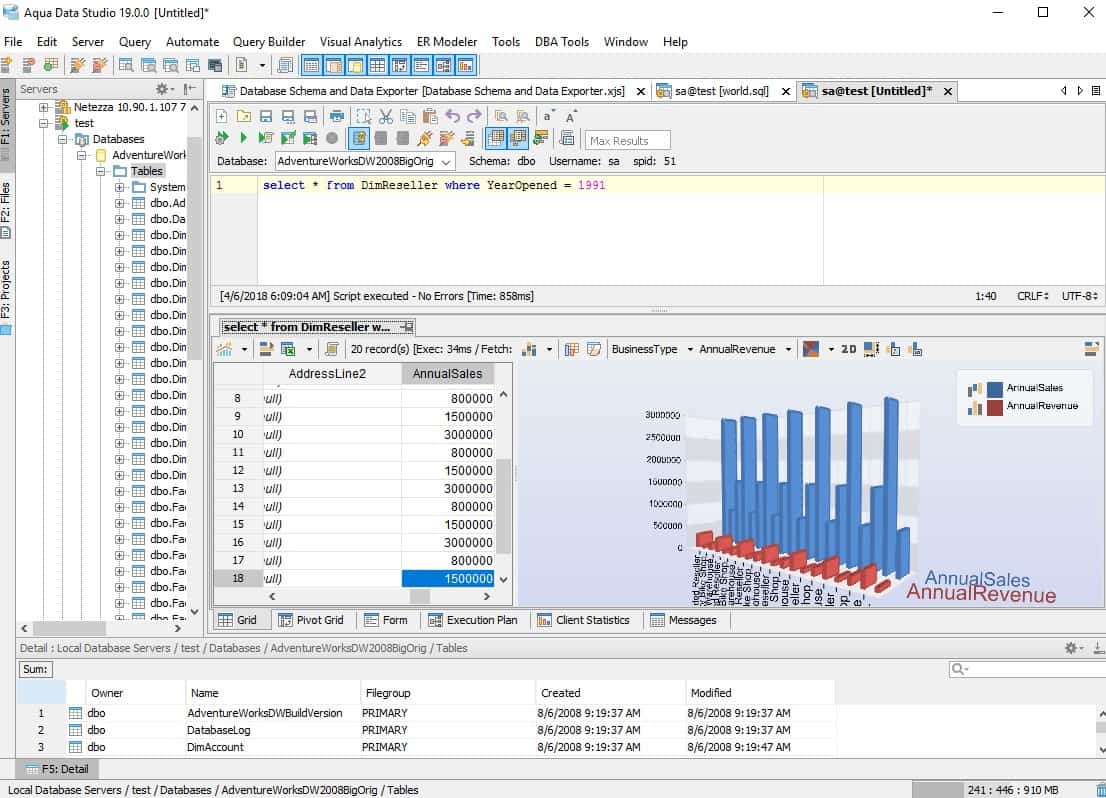
The Aqua Data Studio from Aquafold is a handy tool for those who collaboratively create and manage databases and the applications that access data. The tool can be used to assess existing databases or to create new instances from scratch. Databases are usually designed with applications in mind and so the Aqua Data Studio supports the simultaneous development of queries and database structures.
Key Features:
- Database creation workspace
- Database visualization
- Database creation operation
- Query builder
Aqua Data Studio can be used to develop and analyze databases on premises and on the cloud. The system offers an SSH Terminal to facilitate access to remote servers to access the database management system and access database objects.
The DBMSs that Aqua Data Studio can interact with are Oracle, DB2 LUW, DB2 z/OS, MariaDB, Microsoft SQL Server, MySQL, PostGreSQL, Redshift, Greenplum, ParAccel, Teradata Aster, Netezza, Hive, Spark, Impala, and Sybase.
You can use the system to administer databases as well as create them. Ongoing performance analysis lets DBAs check on the response times of databases and adjust resources accordingly. The development tools in the package include an interactive query builder that helps those with little knowledge of SQL create data access queries to feed into their new applications. The service also supports SQL to insert, update, and delete records, keeping an eye on the performance of indexes.
Pros:
- Links together query performance with database structures
- Creates schemas of databases to promote discussion
- Allows access to the same database design to multiple users
- Import or export database structures
- Guided query creation
Cons:
- A SaaS version would be nice to have
Aquafold Aqua Data Studio runs on Windows, macOS, and Linux. You can access a 14-day free trial to assess the package.
Aquafold Aqua Data Studio Start 14-day FREE Trial
3. Site24x7 SQL Server Monitoring (FREE TRIAL)

Site24x7 is a cloud-based monitoring platform that offers a number of packages to businesses. Site24x7 Infrastructure is a system that supervises networks, servers, and applications and it includes a database monitoring service.
Key Features:
- Database transaction monitoring
- System resource monitoring
- Encrypted connection for data uploads
- Application stack mapping
This monitoring system is able to track the performance of It SQL Server, MySQL, Oracle, PostgreSQL, DB2, MongoDB, VoltDB, Cassandra, CouchDB, and ClickHouse DBMSs databases. Site24x7 Infrastructure also searches running processes to identify connections between applications. This enables it to draw up an application stack, which maps the interdependencies of applications, including databases. The application stack is then a key resource if interfaces or applications show performance issues. It supports root cause traces to check whether the real problem is really with another part of the system. It also identifies the resources of the supporting host that are used by the database and watches their capacity.
The database monitor records total temporary tables, space used by temporary tables, temporary tables on disk, and temporary table removal. It logs read and write activities, slow queries, aborted clients, threads, and open files. The system also tracks database connection usage, aborted connections, and the maximum number of used connections.
Site24x7 Infrastructure database monitoring includes an alerting mechanism that is based on performance and resource availability thresholds. This generates an alert whenever a problem arises. The alerts can be forwarded to technicians by SMS, email, voice call, or instant messaging post.
Pros:
- Flexible cloud-based monitoring option
- Offers a host of out-of-box monitoring options and dashboard templates
- Allows administrators to view dependencies within the application stack, good for building SLAs and optimizing uptime
- Offers root cause analysis enhances by AI to fix technical issues faster
Cons:
- Site24x7 is a feature rich platform with option that extended beyond databases management, may require time to learn all options and features
You can access a 30-day free trial of the service.
Site24x7 Start 30-day FREE Trial
4. ManageEngine Applications Manager (FREE TRIAL)
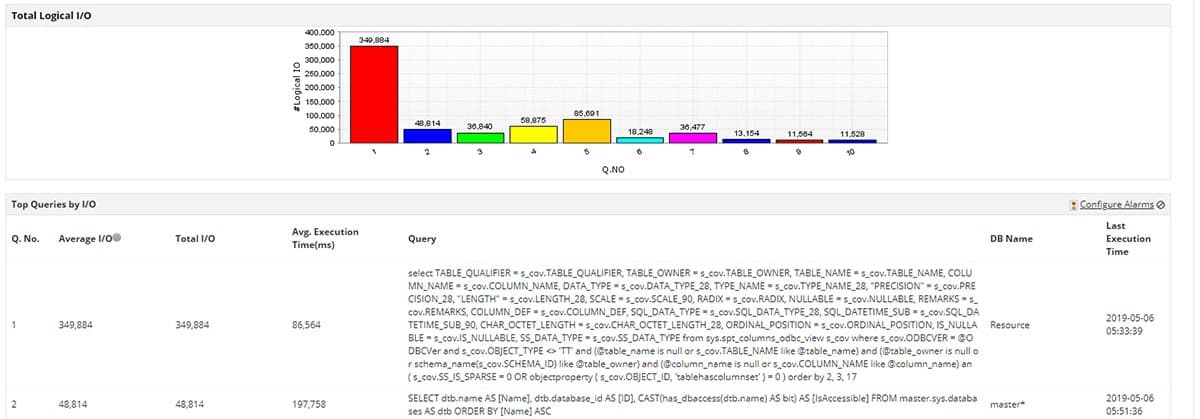
ManageEngine Applications Manager is able to monitor software and services running on-premises and also those based in the cloud. This system can monitor relational database management systems, including Oracle, SQL Server, MySQL, Informix, DB2, Sybase, PostgreSQL, Cassandra, MongoDB, and SAP databases. It can also monitor No SQL systems, in-memory databases, and big data systems.
Key Features:
- On-premises and cloud application monitoring
- Resource usage tracking
- Application dependency mapping
- Live performance monitoring
The Applications Manager tracks all interactions between calling applications and the database. This enables it to spot exactly where performance issues arise – the problem might not necessarily be with the database.
As well as tracking the DBMS activity, the monitor logs the interactions of the database instance with the supporting resources of the host. It checks on disk I/O, cache activity, memory and CPU activity, and system errors. Within the database, the service logs user account access, execution errors, resource locks, and database object usage. The SQL analysis that the tool provides enables DBAs to adjust database objects, such as indexes and views, that can improve SQL performance.
One of the big features of the Applications Manager is its ability to automatically identify all of the applications on a system and how they link together. It creates an application dependency map from its discovery and that live record of connections helps in quickly identifying the root cause of performance problems.
Pros:
- Offers on premise and cloud deployment options, giving companies more choices for install
- Can highlight interdependencies between applications to map out how performance issues can impact businesses operations
- Offers log monitoring to track metrics like memory usage, disk IO, and cache status, providing a holistic view into your database health
- Can automatically detect databases, server hardware, and devices in real time
Cons:
- Can take time to full explore all features and options available
ManageEngine Applications Manager installs on Windows Server or Linux. It is available in three editions: Free, Professional, and Enterprise. You can get a 30-day free trial to put it through its paces risk-free.
ManageEngine Applications Manager Download 30-day FREE Trial
5. SentryOne SQL Sentry (FREE TRIAL)
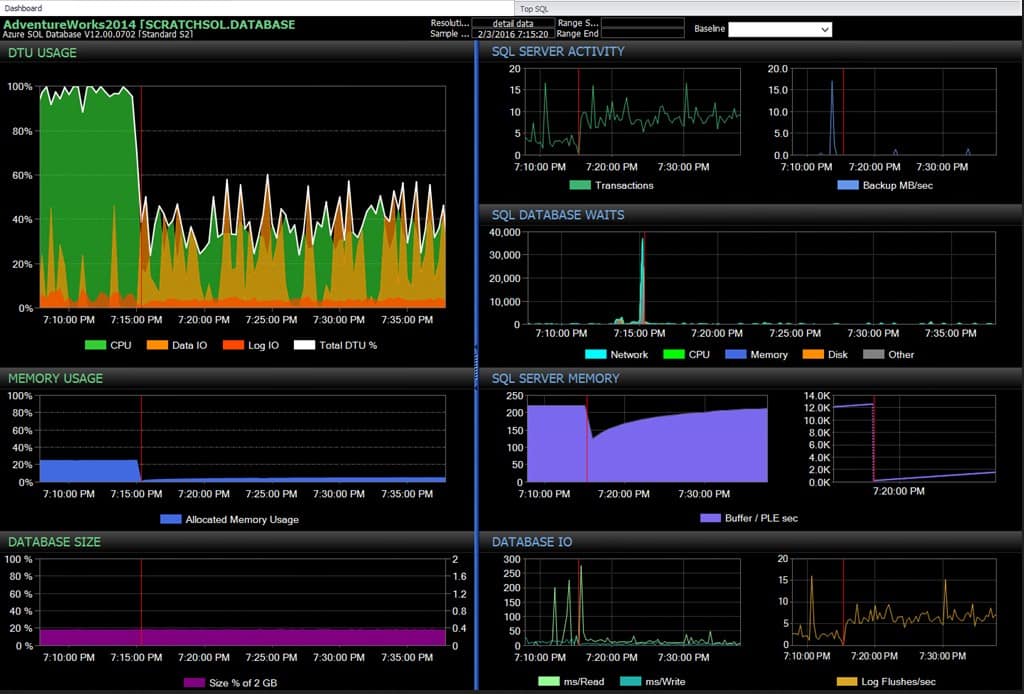
SentryOne SQL Sentry is offered as a service on Azure but the on-premises version is much more flexible. The installed version runs on Windows Server but it can monitor database instances that are resident on other hosts by connecting across the network.
The system can monitor SQL Server running on Linux, on Azure or Amazon platforms, and on Hyper-V or VMWare virtualizations.
Key Features:
- Monitor SQL Server on-premises and on cloud platforms
- Resource availability monitoring
- Watches multiple instances
- Graphics-rich interface
The main monitoring screen of SQL Sentry is crowded with graphs that show live performance data, covering a range of metrics. This allows a single database administrator to watch over many databases at a glance.
As well as tracking live events, the SQL Sentry provides a Performance Analysis dashboard. This shows demand and performance over time. It enables DBAs to estimate trend demand growth and also spots peaks and troughs in database activity.
The system offers a "sample mode," which allows you to pick a specific time and examine all aspects of interaction between server resources and database events.
The long-term view is called "history mode" and lets you see each metric over a timeline that you can adjust. The history mode also provides you with recommendations on where problems have occurred with database performance and what solution could prevent that issue from arising again.
Pros:
- A choice between on-premises and cloud deployment
- Offers an option to sample all metrics at a point in the past
- Includes alerts and warnings for live performance issues
- Traces both host resource availability and usage and database activity simultaneously
- Shows multiple live performance graphs
Cons:
- Focuses on SQL Server and isn't able to monitor other DBMSs
SentryOne SQL Sentry installs on Windows Server or it can be accessed as a service on Azure. You can assess SQL Sentry on a 14-day free trial.
SentryOne SQL Sentry Start 14-day FREE Trial
6. Navicat for MySQL

Navicat for MySQL is a paid SQL management tool that runs on Windows, Linux, and Mac OS. It can connect to the ideal solution for MySQL and MariaDB databases. Another tool by Navicat can connect to PostgreSQL and Navicat Premium will manage a wide range of RDBMSs, including MySQL, MariaDB, PostgreSQL, Oracle, and SQL Server, and administration and development.
Key Features:
- Plug-and-play data migration
- Excellent visualization tool
- Built in Intelligent Database Designer
- Supports SSH Tunneling and SSL for secure connections
The Navicat for MySQL tool can also connect to cloud-based relational databases, such as Google Cloud, Oracle Cloud, Amazon RDS, and Microsoft Azure. This tool supports the creation of database objects as well as the management of data in those tables.
A navigation panel to the left of the GUI window lists the different object types that you can access with the tool. Whichever you select, a list of all of those objects appears in the main screen. Click on an entry to drill down and get details of that object and (in the case of tables) the data it contains. The utility also includes a database design screen to help you create or replan a database.
The interface allows you to connect to two instances simultaneously and contains functions to enable objects to be synchronized between the two. This is a great help for replicating databases and restoring them.
Pros:
- Sleek and easy to use interface
- Includes a visual SQL builder
- Offers code completion for faster implementations
- Supports scheduled reporting, no need to set a reminder every month
Cons:
- Documentation could use improvements, steeper learning curve than some other tools
- Query building interface could be more intuitive
You can get a 14-day free trial of Navicat for MySQL.
7. RazorSQL

RazorSQL is an extensive suite of SQL management tools that will help you run a relational database that is accessed with SQL. The suite is able to communicate with a long list of RDBMSs, including Oracle, MySQL, SQL Server, PostgreSQL, Informix, and Ingres.
Key Features:
- Unifies management access to multiple DBMSs
- Standardized SQL
- Query interpreter
- SQL editor
The interoperability of the tool is particularly useful if you have to deal with several database types on your site. The SQL command set is not exactly the same for all RDBMSs, so you can waste time entering the wrong command format when you switch from one system to another. RazorSQL presents a GUI interface, which it then interprets into commands that get executed in the database. However, if you want to write your own scripts, the utility includes an SQL Editor, which will highlight syntax errors.
The package includes just about all of the functions that you will need in order to administer a database., including backing up data in tables. One thing that is missing from this suite is a form builder that would enable you to create front ends to give your user community safe and easy access to the database.
Pros:
- Designed specifically for for DevOps and DBAs
- Offers syntax highlighting and code completion to help speed up larger projects
- Can generate SQL tables directly from within the tool
- Supports Windows, Linux, and Mac, making it more flexible than some of its competitors
Cons:
- Interface could use improvement, default layout can get cluttered very quickly
This is a paid tool but is very reasonably priced. You can buy the standard package which includes a year of updates and support or opt for more expensive packages with longer support periods. Another dimension in the pricing structure of RazorSQL is the number of people who will use it. The software installs on Windows, Mac OS, and Linux and you can get it on a 30-day free trial.
8. Microsoft SQL Server Management Studio
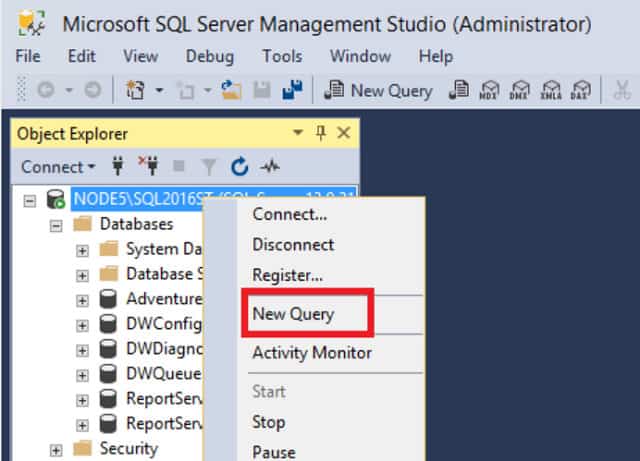
If you use SQL Server for your DBMS, you would benefit from this free tool by Microsoft. This group of utilities includes a graphical tool that enables you to design a database and decide on the tables for it. The database diagrams produced by the tool are useful as components of your project library and system documentation when you are creating a new database or adapting an existing instance.
Key Features:
- Quickly shows database objects
- Fast object creation scripts
- Free to use
The Object Explorer is a straightforward graphical representation of a database, showing the tables that have already been created. Template Explorer is a bundle of object creation scripts with prompts so you can enter the object names as you run them.
Solution Explorer is deprecated – it is included in the package but no longer supported. This tool creates "containers", which bundle together views and scripts that relate to a specific object or group of linked objects.
Pros:
- Offers database management with flexible built in visualizations
- Object explorer is scalable and robust in even large database environments
- Lightweight tool, doesn't demand a large amount of system resources
- Completely free tool
Cons:
- Some features within the tool are depreciated
This lightweight package doesn't include a unifying interface, but the tools will come in useful.
9. MySQL Workbench

MySQL Workbench is a free SQL management tool developed by Oracle. The utility supports database design, development, data management, and migration/backup. The software for the package runs on Windows, Mac OS, and Linux.
Key Features:
- SQL management tool
- Supported by Oracle
- Free to use
All of the utilities of MySQL Workbench are accessed through a unifying visual interface. If you are creating a new database, you start off with the Entity-Relationship Diagram creation tool in the package. The detail screens on this diagram enable you to define all of the requirements for the objects in the database.
The SQL Editor supports the object creation tasks of your database creation project. The Editor presents color-coding for statements and clauses, helping you see immediately whether you have made an error in syntax.
The Visual Performance Dashboard of SQL Workbench helps you check on the delivery speeds of an existing database. You can see where objects and their links need to be optimized as the contents of the database grow. The performance dashboard includes attractive graphical data representations, which make problem recognition a lot easier.
Pros:
- Available on Windows, Linux, and Mac, making it a good OS agnostic option
- Easy to use SQL editor offers color coding and syntax assistance
- Offers built in performance visualization
- Completely free tool
Cons:
- Some nested menus make tasks a bit more cumbersome
The Database Migration function in the Workbench is able to manage backups. It will organize transfers of databases into MySQL sourced from other RDBMSs, including Microsoft SQL Server, Microsoft Access, Sybase ASE, and PostgreSQL. Support for this tool is supplied by a user community forum.
10. TeamDesk

TeamDesk is a little different from the other tools on this list. It isn't a system that helps you manage a DBMS, it is a DBMS. The ethos of TeamDesk is that you don't need to worry too much about how your database is organized. You create an application, such as a contact utility or an invoice creation and query screen and the tool generates a database behind the scenes to support your new screens. The tool includes a library of templates, which helps you work out the layout of your new screens. This is a great assistant that provides you with fields that you might not have thought to put on your new form.
Key Features:
- Cloud based
- Graphical database manager
This is a cloud-based service, so you don't need to install any software in order to use it. You can access the system through a web browser running on any operating system. The configuration of this service and the design of the interface is organized to eradicate the need for you to employ an expert database and network administrator. This makes the tool ideal for a small enterprise, such as an individual or small partnership of owner-workers.
Pros:
- A full fledged DBMS with great collaboration features for DevOp teams
- Operates in the cloud, no complicated onboarding
- Offers built in graphical database management
Cons:
- Interface could use improvement, have to dig for more advanced features
This online package is available in three service levels, which makes it suitable for small to mid-sized businesses. You can create new databases with a free account through the company's website and this includes access to the template library. It is also possible to create a database by uploading a spreadsheet. This will create the structure of the database including necessary tables and populate them, as well, from the data contained in your spreadsheet. The free account is active for 14 days. Then you will need to pay for the service.
11. TablePlus

TablePlus is a graphical data visualization interface for a range of RDBMS brands. It is capable of connecting to and displaying databases written in MySQL, PostgreSQL, SQL Server, Oracle, and SQLite, among others. The software for the tool installs on Windows and Mac OS.
The interface can be adapted to different themes. The connection between the front end and your database is encrypted and you can also apply multi-level authentication to access the database application. Although ease of use of the graphical user interface makes database exploration a task that non-technical staff could use, this isn't intended as an end-user tool. It is a support facility for developers and DBAs. The SQL assistant built into the tool is an assistant to trained programmers rather than an automated script generator for untrained staff.
The data browser reads in records from a selected table, enabling you to view, edit, or delete them. An SQL editor helps you to develop scripts through color-coded statement and clause recognition. This editor includes statement formatting and an autocomplete feature.
A data management function enables you to export a database including its data and import that data back again. This is a useful assistant for backup and recovery procedures.
Pros:
- Interface is easier to use than other DBMSs
- Supports multiple database formats including Oracle, SQLite, and MySQL
- Is a solid cross platform solutions for Windows and Mac
- Convenient SQL Assistant helps aid programmers by highlighting issues, and offering suggestions for query improvements
Cons:
- Some task can feel delayed, no visual cue that they executed or not
You can get a free trial version of the system, which has operational limits. The pricing structure is based on the number of terminals that you install the software on. The license lets you use the software forever, but the support package that is included lasts for only one year. You get a 7-day money-back guarantee.
12. Sequel Pro

Sequel Pro is only available for Macs. It installs on Mac OS 10.6 and higher. This is a free SQL management tool, but you are able to make a donation to the developers if you wish.
This tool is able to interface with MySQL relational databases. You can connect to any database as long as the computer it is on is accessible via the network. This is an open-source project, so you can copy the source code and adapt it. If you have programming skills you could also contribute to the project and submit any improvements you make to be adapted into the core program for others to download. The software is updated every night.
The layout of the Sequel Pro window is a little like a file explorer. A left-hand pane shows all of the tables in your database and the main panel shows all of the records in the currently-selected table. You can also enter SQL queries into the interface and get the results shown in the data viewer. It is possible to use Sequel Pro to export data from your database.
The tool will also import stored data back into your database, or will create the same tables in another database instance and populate it with the data that you backed up.
Pros:
- Completely free Mac database manager
- Interface is intuitive, easy to navigate the file explorer even in large databases
- Suited for small to medium size databases
Cons:
- Not available for Windows
- Doesn't support as many version of SQL as other options
13. phpMyAdmin
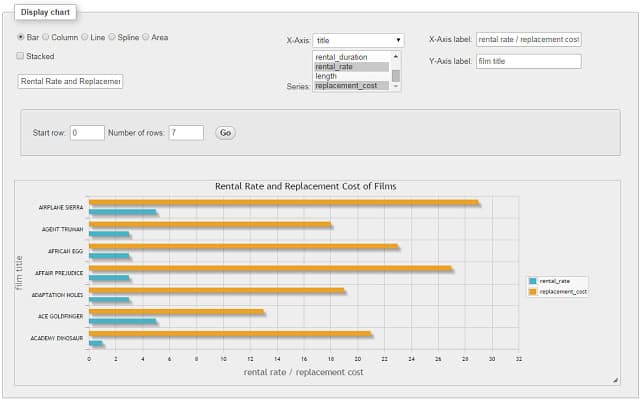
The phpMyAdmin utility is a free open source tool for interfacing with your MySQL or MariaDB database. This software will run on Windows and Linux. You can specify that the app enforces two-factor authentication for access control. The tool is a little complicated to set up, so it would be better as an aid to those who have technical training. The actions that the tool allows you to perform on your data also suggest that this is not a desktop database application for end-users in a big corporation.
You can create, alter, and remove tables and other database objects with this tool. It is also possible to manage user accounts on the database through phpMyAdmin. An SQL editor enables you to develop and execute your own scripts in the relational database. Other functions include the ability to export the entire database to file through the tool – it will also guide you through importing the instance back in from those files.
Pros:
- Completely free and open-source tool
- Operates on both WIndows and Linux systems
- Offers a robust SQL editing tool
- Exports are easy to execute, and allows for a variety of formats
Cons:
- Interface is limited, graphical representations can be improved and made easier to read
14. SQLyog
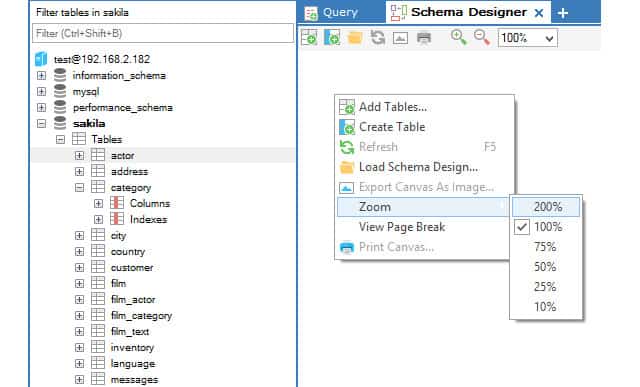
SQLyog is an administration tool for MySQL relational databases and it runs on Windows. The tool is a useful aid to administration because it can export and import databases. You can schedule backups of your database to occur overnight. It is also possible to use SQLyog in order to synchronize between two versions of the same database. Thus, you can mirror your databases for instant recovery, or in order to maintain a test database.
This utility's strengths lie in its ability to analyze existing databases and improve their configurations. It won't give you advice on normalization, but it will examine the indexes in your database and identify those that conflict. It will also examine your SQL statements and recommend how they could be improved to enhance the speed that results are returned.
The features of this SQL management tool are very sophisticated, and it is aimed at database administrators. However, its ease of use makes it a good option for individuals running a database without extensive training.
Pros:
- Lightweight tool, ideal for quick tasks such as mirroring and recovery
- UI is simple, but not limited or overly complicated
- Can compared databases and cross examine indexes
- Feels intuitive, even for junior DBAs
Cons:
- Could use a longer trial time for testing
It is a useful facility to close your skills gap. This tool is charged per user. It is available on a 14-day free trial.
15. Knack

Knack isn't just a database analysis tool, but an entire DBMS. This is a cloud-based service that stores your database engine for you. So, you have two options; you could either use this service to back up your onsite database and optimize it, and copy down the improved database back to your home database server, or you could do away with your on-premises database entirely.
A backup service is built into a Knack subscription. The company creates mirrors of your database engine onto multiple sites to ensure that a catastrophe at its main data center wouldn't lose your data. Whether or not the continuity of this service is enough to provide you with recoverability is a risk that you would have to assess yourself.
This is a very good solution for small businesses. It includes templates for your database front ends, which include maps, credit card processing, input and query forms, and reports. You can also interface it to well-known apps, such as MailChimp and Dropbox.
Pros:
- Highly visual, great for long term monitoring or NOC environments
- Lightweight application hosted in the cloud
- Built with smaller businesses in mind
- Offers front end templates for improved time to market
Cons:
- Not the best option for larger companies looking for IDE features
- Could benefit from a longer trial period
The service is charged for on a monthly subscription with three plan levels, which makes it suitable for businesses of all sizes. Knack is available on a 14-day free trial.
Database Management Software FAQs
How do you monitor database health?
The issue of database health covers a wide range of topics. These include performance issues and also security matters. Performance issues can be heavily influenced by the capacity of supporting infrastructure as well as the efficiency of the DBMS and the manner in which data is organized and indexed. Covering all of these factors requires automated monitoring tools.
What is the importance of database reporting?
Database reporting allows a database administrator to keep tabs on the available capacity of the database. Performance and capacity tracking allow planners to ensure that the database has sufficient resources available to it so that it can continue to support the business.
What are database management system requirements?
There are many different database management systems (DBMSs) available commercially. Oracle, MySQL, PostgreSQL, Microsoft Access, SQL Server, MariaDB, Microsoft Access, and MongoDB are just a few examples.
A Web Based Relational Database Design Tool To Perform Normalization
Source: https://www.comparitech.com/net-admin/database-management-tools-software/
Posted by: millernuals1966.blogspot.com

0 Response to "A Web Based Relational Database Design Tool To Perform Normalization"
Post a Comment